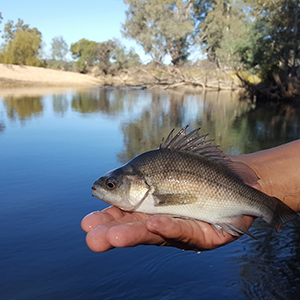Larval fish sensitivity to a simulated cold-water pulse varies between species and age

Accepted: 27 June 2022
Supplementary: 161
HTML: 135
All claims expressed in this article are solely those of the authors and do not necessarily represent those of their affiliated organizations, or those of the publisher, the editors and the reviewers. Any product that may be evaluated in this article or claim that may be made by its manufacturer is not guaranteed or endorsed by the publisher.
Authors
The release of cold-water from hypolimnetic zones of impoundments sharply reduces downstream riverine water temperature. This cold-water pollution (CWP) can extend for hundreds of kilometres, severely challenging the physiological ability of aquatic fauna, particularly ectotherms such as fish, to maintain essential processes such as metabolism, development and growth and survival. The impact of CWP on native fish, especially early life stages, is poorly known. We investigated the effect of a 24-hour exposure to a range of environmentally-related water temperatures (8, 10, 12, 14, 16, 18 and 20°C) on three age-classes (<24-hour-old, 7-day and 14-day-old larvae) of two Australian native fish species: Murray cod (Maccullochella peelii) and Macquarie perch (Macquaria australasica). Overall, larvae of M. peelii were more sensitive to lower water temperatures and hence CWP than M. australasica, indicated by higher rates of equilibrium loss. Larvae of M. peelii were most sensitive to exposure at seven days old whereas M. australasica larvae were most sensitive at <24-h-old. Using our results, we modelled pre- and post-impoundment temperature scenarios and estimated the downstream CWP footprint for both species in an Australian river reach. Larvae of M. peelii were predicted to be absent from the first 26 km of river downstream of the impoundment compared with no impact on the distribution of M. australasica. Managing riverine water temperature below impoundments is fundamental to promoting positive outcomes for endemic fish on not only a local, but global basis. This study emphasises the differential impact of CWP among the critical early life stages and fish species and highlights the urgent need to better manage hypolimnetic water releases to improve downstream river ecosystems.
Edited by
Pietro Volta, CNR-IRSA Verbania, ItalyHow to Cite

This work is licensed under a Creative Commons Attribution-NonCommercial 4.0 International License.
Similar Articles
- Roberto M. CENCI, The use of aquatic moss (Fontinalis antipyretica) as monitor of contamination in standing and running waters: limits and advantages , Journal of Limnology: Vol. 60 No. s1 (2001): Scientific and legal aspects of biological monitoring in freshwater
- Antonio Di Sabatino, Giovanni Cristiano, Patrizia Vignini, Francesco Paolo Miccoli, Bruno Cicolani, A modification of the leaf-nets method for sampling benthic invertebrates in spring habitats , Journal of Limnology: Vol. 77 No. 1 (2018)
- Ubirajara L. Fernandes, Elaine C.C. de Oliveira, Sírleis R. Lacerda, Role of macrophyte life forms in driving periphytic microalgal assemblages in a Brazilian reservoir , Journal of Limnology: Vol. 75 No. 1 (2016)
- Sameer M. Padhye, Henri J. Dumont, Species richness of Cladocera (Crustacea: Branchiopoda) in the Western Ghats of Maharashtra and Goa (India), with biogeographical comments , Journal of Limnology: Vol. 74 No. 1 (2015)
- Ning Lei, Chaonan Zhang, Yanchao Wang, Junjie Zhu, Study on the immune enhancers against Micropterus salmoides rhabdovirus infection , Journal of Limnology: Vol. 83 (2024)
- Robert M. BACA, Stephen T. THRELKELD, Inland dissolved salt chemistry: statistical evaluation of bivariate and ternary diagram models for surface and subsurface waters , Journal of Limnology: Vol. 59 No. 2 (2000)
- Paul LOGAN, Ecological quality assessment of rivers and integrated catchment management in England and Wales , Journal of Limnology: Vol. 60 No. s1 (2001): Scientific and legal aspects of biological monitoring in freshwater
- Chantal Audet, Shannon MacPhee, Wendel Keller, Colonization of constructed ponds by crustacean zooplankton: local and regional influences , Journal of Limnology: Vol. 72 No. 3 (2013)
- Rosaria Lauceri, Mariano Bresciani, Andrea Lami, Giuseppe Morabito, Chlorophyll a interference in phycocyanin and allophycocyanin spectrophotometric quantification , Journal of Limnology: Vol. 77 No. 1 (2018)
- Valeria Lencioni, Enrico Mezzanotte, Camilla Spagnol, Leonardo Latella, Effects of human impacts on diversity and distribution of chironomids (Diptera: Chironomidae) in prealpine springs , Journal of Limnology: Vol. 77 No. s1 (2018): Recent advances in the study of Chironomidae: An overview
<< < 41 42 43 44 45 46 47 48 49 50 > >>
You may also start an advanced similarity search for this article.
-
John D. Koehn, Charles R. Todd, Henry Wootton, Michael JoyMarine and Freshwater Research : 2023

 https://doi.org/10.4081/jlimnol.2022.2056
https://doi.org/10.4081/jlimnol.2022.2056





